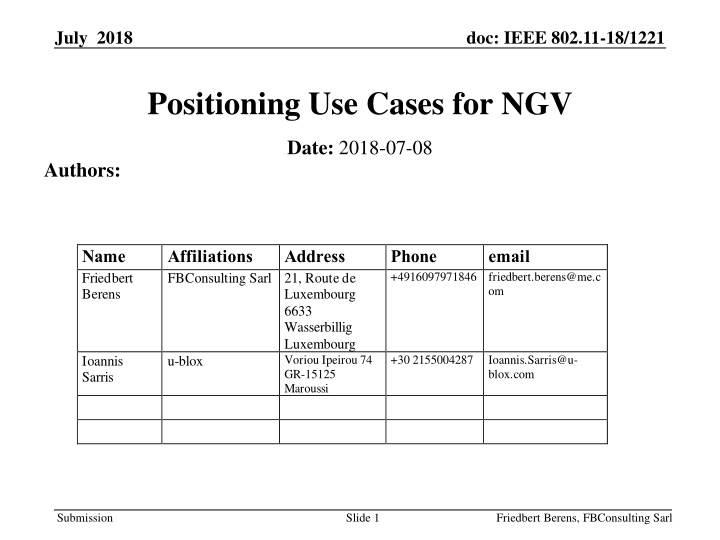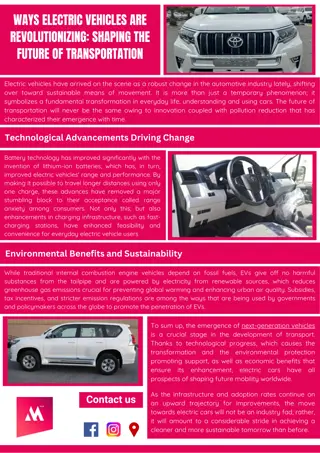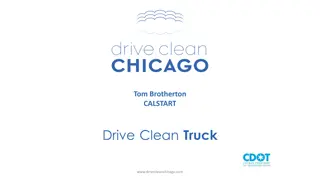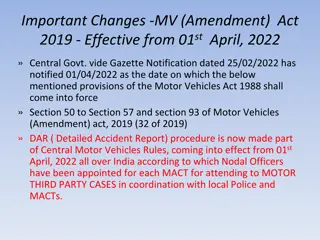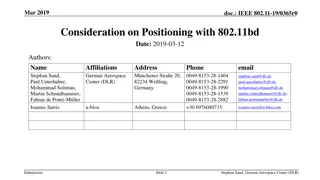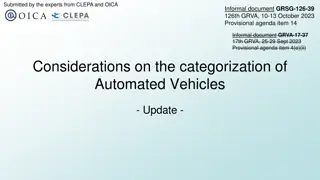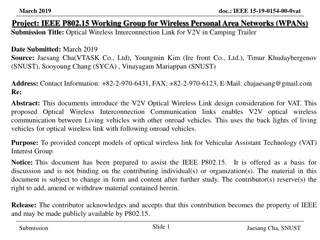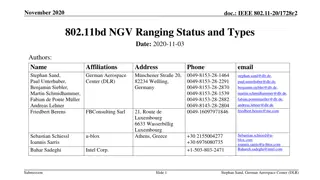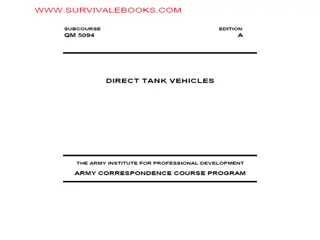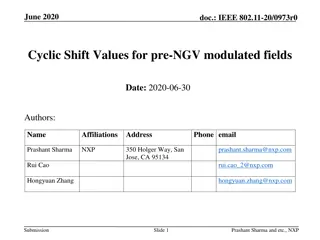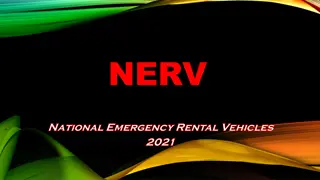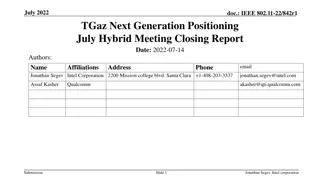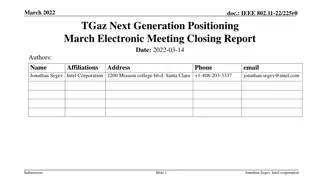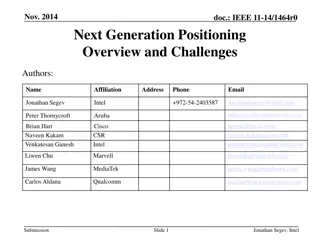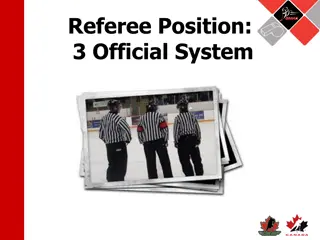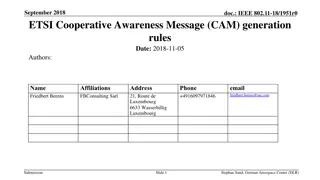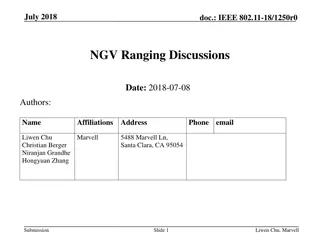Enhanced Positioning Services for Next-Generation Vehicles (NGV)
This document discusses the use cases, general considerations, and key requirements for enhanced positioning services in Next-Generation Vehicles (NGV). It covers potential environments, support for 802.11p modes, and specific use cases like pedestrian detection and warning. The focus is on improving positioning accuracy, reliability, and safety in dynamic urban and suburban environments for both pedestrians and vehicular users.
Download Presentation

Please find below an Image/Link to download the presentation.
The content on the website is provided AS IS for your information and personal use only. It may not be sold, licensed, or shared on other websites without obtaining consent from the author.If you encounter any issues during the download, it is possible that the publisher has removed the file from their server.
You are allowed to download the files provided on this website for personal or commercial use, subject to the condition that they are used lawfully. All files are the property of their respective owners.
The content on the website is provided AS IS for your information and personal use only. It may not be sold, licensed, or shared on other websites without obtaining consent from the author.
E N D
Presentation Transcript
July 2018 doc: IEEE 802.11-18/1221 Positioning Use Cases for NGV Date: 2018-07-08 Authors: Name Friedbert Berens Affiliations FBConsulting Sarl 21, Route de Address Phone +4916097971846friedbert.berens@me.c om email Luxembourg 6633 Wasserbillig Luxembourg Voriou Ipeirou 74 GR-15125 Maroussi +30 2155004287 Ioannis.Sarris@u- blox.com Ioannis Sarris u-blox Submission Slide 1 Friedbert Berens, FBConsulting Sarl
July 2018 General consideration concerning enhanced positioning services in NGV What are potential environments? All transportation with speeds from 3km/h onwards from pedestrian to high-speed trains IEE802.11 is the basis for V2V and V2x cooperative communication (802.11p) and future NGV extensions US: IEEE WAVE EUROPE: ETSI ITS-G5 Positioning relies mainly on GNSS based methods using GPS Limited precision (2m 7m) depending on environment Enhanced positioning in 802.11 could open up new applications for V2X communications systems in NGV Inclusion of pedestrians, bicycles and motorbikes High precision lane assistance in dense traffic environments In-out detection for tolling and parking applications Enhanced safety application and autonomous driving applications doc: IEEE 802.11-18/1221 Submission Slide 2 Friedbert Berens, FBConsulting Sarl
July 2018 doc: IEEE 802.11-18/1221 General requirements Support of 802.11p modes including 10MHz channel bandwidth Consideration of highly mobile environment Update rates of up to 30Hz (C-ACC and Platooning) Channel models in dynamic environment Relative positioning using the ad-hoc communication mode of 802.11p Inclusion infrastructure stations with absolute positioning Submission Slide 3 Friedbert Berens, FBConsulting Sarl
July 2018 doc: IEEE 802.11-18/1221 Use case 1: Pedestrian detection and warning User: Persons participating as pedestrian in urban and suburban road traffic at pedestrian crossing and walkways Drive of vehicles equipped with cooperative ITS system based on IEEE802 NGV (WAVE, ITS-G5) Environment: Dynamic urban and suburban outdoor environments with high road traffic and pedestrian density Use case: Pedestrian/Vulnerable road user portable WAVE or ITS-G5 device based on 802.11NGV technology sends out periodic messages including positon and type information every 0.1sec to 5 sec Vehicular stations send out messages with period of up to 10Hz Pedestrian station can be warned from approaching cars Vehicular user can recognize pedestrian/vulnerable road user in system overview Submission Slide 4 Friedbert Berens, FBConsulting Sarl
July 2018 doc: IEEE 802.11-18/1221 Key Performance and Attributes Linear precision and accuracy/reliability and along street For persons/pedestrians: <0.25m@95% per measurement Horizontal accuracy with respect to local reference system(e.g. pedestrian crossing): For pedestrians: <0.25 m@95%, Vertical accuracy for multi level crossings: For pedestrians: <2 m@95%, Latency: < 100ms Refresh Rate: > 1-10 location/sec/user Number of simultaneous users: < 250 Submission Slide 5 Friedbert Berens, FBConsulting Sarl
July 2018 doc: IEEE 802.11-18/1221 Use case 2: Free-flow tolling operation User: Environment: Highly dynamic urban, suburban and rural outdoor environments with high road traffic Use case: Infrastructure ITS-G5 or WAVE station monitoring a very specific area/section of road Road toll, City toll, tunnel tolling Vehicular stations send out messages with period of up to 10Hz Infrastructure recognizes the crossing of a vehicular station with speeds up to 200km/h (125Miles/h) Drive of vehicles equipped with cooperative ITS system based on IEEE802 (WAVE, ITS-G5) Road operator managing roads or parts of roads Submission Slide 6 Friedbert Berens, FBConsulting Sarl
July 2018 doc: IEEE 802.11-18/1221 Typical free flow scenario Submission Slide 7 Friedbert Berens, FBConsulting Sarl
July 2018 doc: IEEE 802.11-18/1221 Key Performance and Attributes Linear accuracy along street <1 m@95% per measurement Differentiation of road users Horizontal accuracy with respect to local reference system (single lane detection): Vehicular: <1.00 m@99%, Differentiation of cars in different lanes Vertical accuracy: not required, street level only Latency: < 100ms Refresh Rate: > 1- 10 locations/sec/user Number of simultaneous users: < 250 Submission Slide 8 Friedbert Berens, FBConsulting Sarl
July 2018 doc: IEEE 802.11-18/1221 Summary Two use cases for enhanced positioning for NGV have been presented The specific requirements of these environments are proposed to be added to the NGV requirement set High update rate of position information High number of simultaneous users High reliability requirements These use cases are covered by using NGV based system in vehicular environments Submission Slide 9 Friedbert Berens, FBConsulting Sarl
